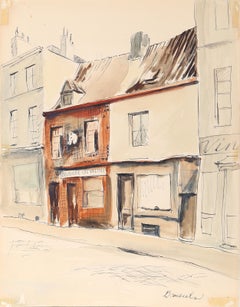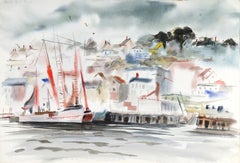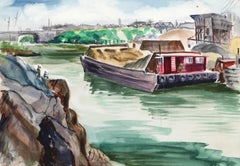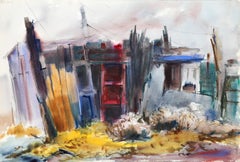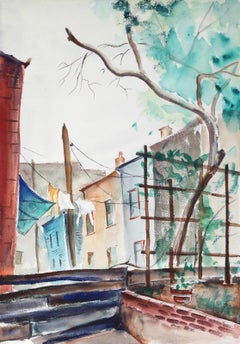Tri-State Area - Landscape Drawings and Watercolors
1950s Impressionist Tri-State Area - Landscape Drawings and Watercolors
Ink, Watercolor
1950s Impressionist Tri-State Area - Landscape Drawings and Watercolors
Watercolor
1960s Impressionist Tri-State Area - Landscape Drawings and Watercolors
Watercolor
1940s Impressionist Tri-State Area - Landscape Drawings and Watercolors
Watercolor
1960s Impressionist Tri-State Area - Landscape Drawings and Watercolors
Watercolor
1940s Impressionist Tri-State Area - Landscape Drawings and Watercolors
Watercolor
1950s Impressionist Tri-State Area - Landscape Drawings and Watercolors
Watercolor
1960s Impressionist Tri-State Area - Landscape Drawings and Watercolors
Watercolor
1950s Impressionist Tri-State Area - Landscape Drawings and Watercolors
Watercolor
1960s Impressionist Tri-State Area - Landscape Drawings and Watercolors
Watercolor
1960s Impressionist Tri-State Area - Landscape Drawings and Watercolors
Watercolor
1950s Impressionist Tri-State Area - Landscape Drawings and Watercolors
Watercolor
1950s Impressionist Tri-State Area - Landscape Drawings and Watercolors
Watercolor
2010s Contemporary Tri-State Area - Landscape Drawings and Watercolors
Paint, Paper, Color Pencil
2010s Expressionist Tri-State Area - Landscape Drawings and Watercolors
Charcoal, Pastel, Archival Paper
1970s Surrealist Tri-State Area - Landscape Drawings and Watercolors
Ink
2010s Contemporary Tri-State Area - Landscape Drawings and Watercolors
Monotype, Archival Paper
1910s American Realist Tri-State Area - Landscape Drawings and Watercolors
Paper, Watercolor
21st Century and Contemporary Surrealist Tri-State Area - Landscape Drawings and Watercolors
India Ink, Watercolor
2010s Photorealist Tri-State Area - Landscape Drawings and Watercolors
Paper, Graphite
2010s Expressionist Tri-State Area - Landscape Drawings and Watercolors
Pastel, Archival Paper
1970s Surrealist Tri-State Area - Landscape Drawings and Watercolors
Ink, Mixed Media, Graphite
1960s Folk Art Tri-State Area - Landscape Drawings and Watercolors
Paper, Watercolor, Ballpoint Pen, Color Pencil
Early 20th Century Modern Tri-State Area - Landscape Drawings and Watercolors
Crayon
2010s Tri-State Area - Landscape Drawings and Watercolors
Archival Pigment
Mid-20th Century Modern Tri-State Area - Landscape Drawings and Watercolors
Paper, Oil Pastel
Mid-20th Century Modern Tri-State Area - Landscape Drawings and Watercolors
Paper, Charcoal
2010s Assemblage Tri-State Area - Landscape Drawings and Watercolors
Charcoal, Acrylic, Archival Paper, Magazine Paper
2010s Expressionist Tri-State Area - Landscape Drawings and Watercolors
Pastel, Archival Paper
2010s Contemporary Tri-State Area - Landscape Drawings and Watercolors
Watercolor, Archival Paper
2010s American Realist Tri-State Area - Landscape Drawings and Watercolors
Archival Paper, Graphite
2010s Expressionist Tri-State Area - Landscape Drawings and Watercolors
Pastel, Archival Paper
2010s Tri-State Area - Landscape Drawings and Watercolors
Porcelain, Ink, Digital
1970s Contemporary Tri-State Area - Landscape Drawings and Watercolors
Paper, Watercolor
21st Century and Contemporary Romantic Tri-State Area - Landscape Drawings and Watercolors
India Ink
Mid-20th Century Modern Tri-State Area - Landscape Drawings and Watercolors
Paper, Charcoal
2010s Tri-State Area - Landscape Drawings and Watercolors
Porcelain, Ink
Mid-20th Century Modern Tri-State Area - Landscape Drawings and Watercolors
Paper, Charcoal
21st Century and Contemporary American Realist Tri-State Area - Landscape Drawings and Watercolors
Archival Paper
2010s Abstract Tri-State Area - Landscape Drawings and Watercolors
Ink, Archival Paper
2010s Abstract Tri-State Area - Landscape Drawings and Watercolors
Ink, Archival Paper
Early 2000s Abstract Tri-State Area - Landscape Drawings and Watercolors
Ink, Archival Paper
Early 2000s Abstract Tri-State Area - Landscape Drawings and Watercolors
Ink, Archival Paper
2010s Tri-State Area - Landscape Drawings and Watercolors
Paper, Monotype
1930s American Realist Tri-State Area - Landscape Drawings and Watercolors
Paper, Ink, Watercolor
1980s Photorealist Tri-State Area - Landscape Drawings and Watercolors
Archival Ink, Archival Paper
2010s Contemporary Tri-State Area - Landscape Drawings and Watercolors
Paper, Watercolor
21st Century and Contemporary American Realist Tri-State Area - Landscape Drawings and Watercolors
Paper, Watercolor
1960s Modern Tri-State Area - Landscape Drawings and Watercolors
Paper, Oil Pastel
2010s Expressionist Tri-State Area - Landscape Drawings and Watercolors
Pastel, Archival Paper
2010s American Modern Tri-State Area - Landscape Drawings and Watercolors
Mixed Media, Acrylic, Charcoal
2010s Surrealist Tri-State Area - Landscape Drawings and Watercolors
Paper, Pastel
21st Century and Contemporary American Realist Tri-State Area - Landscape Drawings and Watercolors
Paper, Watercolor
21st Century and Contemporary Contemporary Tri-State Area - Landscape Drawings and Watercolors
Archival Paper, Graphite
1980s American Modern Tri-State Area - Landscape Drawings and Watercolors
Paper, Pastel
2010s Realist Tri-State Area - Landscape Drawings and Watercolors
Charcoal, Archival Paper, Graphite
Early 2000s Contemporary Tri-State Area - Landscape Drawings and Watercolors
Gold Leaf
2010s Expressionist Tri-State Area - Landscape Drawings and Watercolors
Pastel, Archival Paper
2010s American Modern Tri-State Area - Landscape Drawings and Watercolors
Mixed Media, Acrylic
2010s Contemporary Tri-State Area - Landscape Drawings and Watercolors
Watercolor, Archival Paper
